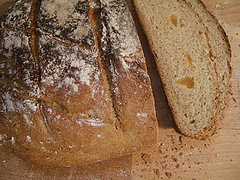
We all have shakey egos. So, it's always lovely to hear, "You're a life saver!" But, for me, along with the squishy good feeling I get from that comment, I also have a quiet little cry. The credit shouldn't go to me. The ultimate strength comes from within each woman in labour.
So, I'm really happiest when I talk with a client, months after her baby's birth, and she stops mid-sentence and says, "Did I ever tell you how wonderful that foot massage was? It helped me to be in my body, to focus on the work I was doing. It made me feel powerful."
For me, being a doula is all about reminding the woman that it's all HER power - internally and externally. As well as owning the power of her labour, she also has rights and responsibilities, which she's fully capable of exercising.
I've had my births, I've worked through my own stuff. And like my daughter says, "You check your stuff at the door." For me, being a doula isn't about "giving" a woman the birth I think she needs. It's about helping her to access her own truth, drawing on her own life experiences. She has nine months to do the work of establishing her own boundaries, re-evaluating relationships, and preparing for the emotional work of birth. Because, contrary to popular belief, this is not a physical game, it's a mental and emotional game. And the demons are ones that you've met before...
One former client thought I could guarantee her a quick, painless labour, and achieve an "ideal birth." Sorry, I can't do that...
I can translate what's happening, tease out the meaning in the medical jargon, de-mystify the logic of the body, anticipate possible scenarios. I can help facilitate the transition INTO labour and THROUGH labour. But I can't alter a woman's own life experience, her beliefs and expectations, or the variable reality of this particular birth day.
It would be presumptuous (and egotistical) to think that I could make any guarantees, or have as a goal to help each woman achieve an "ideal birth." Who is to say what is the "ideal birth" for each woman? I really believe that each of us has the labour that fits us. I don't think that belief is a cop-out or just me being fatalistic. I need to support each woman through her own experience of birth, without ego or judgement. If I can't support her choices (which would place her or her baby at extreme risk), then I must be honest about my own limits, and respectfully decline care.
As a doula, I carry with me the experience of hundreds of births. Each birth teaches me something more about women's lives, our bodies, our strengths, our weaknesses. Each birth teaches me even more about relationships, communication, and random interaction.
My job is to sift through all the gifts I've been given from each birth, to help each woman find her own way through her own birth experience. My job is to fade into the background as she discovers her own power. My job is also to provide her partner with the tools that he or she needs on that day, so that they can work together with the baby through the process.
As part of my care, I do a final "dress rehearsal" visit to each family's home. We try out positions, see what pieces of furniture might work well to lean on, if there's a "circuit" in the house to pace, how wonderful the cold tiles feel on the feet. Yesterday, I knew things were serious when the phone call came, "She's doing tippy toes! Oh, and she only made it half way up the stairs before the next contraction came! We'll meet you at the hospital." Rather than questioning their decision, I knew that, having given them the tools to recognize strong active labour, they were right on track.
When we met at the hospital, one nurse said, "I knew they must be with you. They knew what to do, and she wasn't worried about making noise. Did you tell her to make so much noise that we'd bypass admitting? (I grinned) Well, it worked! She's in Room 1."
It's so wonderful to do all the prep work with clients - to give them the tools that they need to labour in their own way. This morning, I encouraged the dad to rock his wife's hips, while she lay on her side, oxygen mask on, breathing calmly and deeply, waiting for the baby's heartrate to rise. He was able to feel the direct impact of his hands on the baby's heartrate. The rocking stimulated the baby, and kept the baby safe.
When we were all tired, we welcomed the body-building nurse, as he held the woman in his arms, chanting as she pushed, "Yeyeyeyeye... goodygoodygoodygoody... ohhh... ohhh... that's good!" The dad and I grinned at each other. We were working as a team, to honour the woman's wishes.
As wind-surfers, this couple understand the need for working with the wind, whichever way it blows. That understanding helped them to cope with the challenging labour that they faced. They were able to achieve the birth that was right for them and their daughter.
After birth, this baby, who had spent most of the labour star-gazing (aka "posterior"), laid on her back on her mum's tummy, tilting her head back to view the nurse, smiling quietly, then turning her gaze to her mum.
Then mother and daughter practised sticking their tongues out at each other, while dad giggled.
It was that family's "ideal birth." They had witnessed the body's power, the power of labour, and the power of great communication and understanding. It will take them a long way in their journey as a family.
...and I happily slipped away.
- Jacquie Munro, Vancouver Doula

































